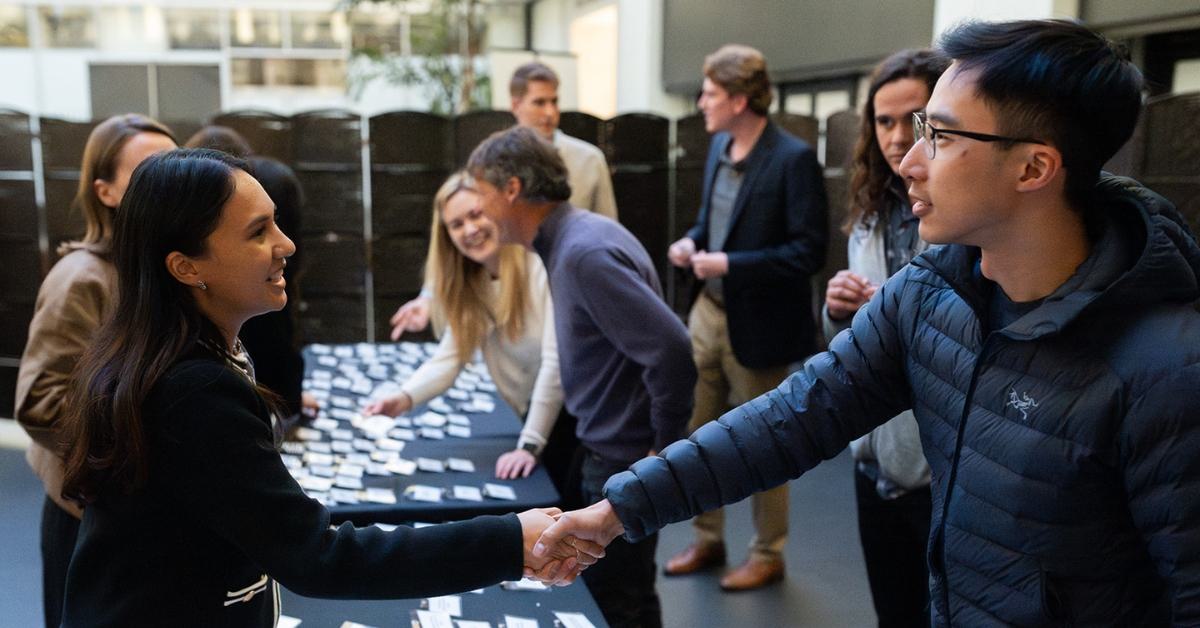
Adapt or Collapse: Five Lessons for Scaling Sustainability to Drive Growth

As investors committed to the Climate Transition, we believe substantive, long-term relationships with industry stakeholders are essential because they can lead to positive outcomes at scale. To illustrate the influence of established market players, consider their market share. The top 8 grocery stores in the U.S. account for over 50 percent of U.S. food sales, the top 10 freight carriers operate 85 percent of global shipping capacity, and over 70 percent of the installed wind and solar capacity worldwide is accounted for by 10 companies. If we are going to decarbonize, these organizations are a critical part of the story.
Our work over the last 10 years has centered on tackling a critical friction point in the global sustainability journey: scaling solutions that generate ROI while reducing the environmental impact of business. The urgency of this mission cannot be overstated, and our team at S2G has been at the forefront of this challenge, engaging with over 600 organizations in the last 18 months alone.
The entities we engage with run the gamut from major grocers to logistics providers, maritime shippers to power and utilities, global ingredient suppliers to multi-generational growers, and government organizations tasked with everything from monitoring and protecting our oceans to launching sustainability-linked financing programs. Our goal has been clear — to understand each organization’s strategic priorities, sustainability objectives and growth paths to explore how our risk capital, extensive network, and diverse portfolio can help them achieve those goals. I am sharing my learnings from the last several years in the event they can be helpful to others in the field and to collectively look for ways to be faster, better and more sustainable together.

The Value of New Business Ventures and Ongoing Challenges
In today’s rapidly changing market, 50 percent of CEOs expressed strong interest in new business endeavors. These ventures are highly valued by the market, often yielding a 2x return compared to core business operations, due to their potential for new revenue streams and faster growth. The current challenging market conditions for startups offer established corporations a unique opportunity to embrace the new economy.
As of late August 2024, over 136,000 employees have been laid off from 422 tech companies — which follows a trend of significant workforce reductions that began in late 2022 and has led to more talent being available. Technologies that offer a lower environmental footprint continue to come down the cost curve. New business models — like Hardware-as-a-Service models — are unlocking value and reducing friction points to technology adoption. Governments are providing carrots and sticks to encourage decarbonization; combining the IRA, BIL, and other legislative efforts, the U.S. government has made more than $430 billion available for decarbonization since 2021.
Despite these efforts and opportunities, we are not moving fast enough. Companies are facing challenges in fulfilling their sustainability commitments. Data from CDP indicates that 30% of companies are significantly lagging on their Scope 1 and 2 emissions reduction targets, with nearly half falling short on Scope 3 goals.
As a result, numerous businesses are reevaluating, adjusting, or even retracting their climate pledges. By March 2024, 29% of companies participating in the Science Based Targets Initiative’s Business Ambition for 1.5°C campaign were removed due to noncompliance. In 2022, governments spent $1 trillion subsidizing fossil fuel consumption, more than they spent on clean energy transitions. Surprised to see increased seafood prices? The Alaskan snow crab season has been canceled two years in a row after 10 billion crabs effectively starved to death due to warming oceans. Have you talked to anyone in Florida or California recently about their home insurance options? After seeing a 5 to 7 percent annual growth trend in global insured natural catastrophe losses since 1994, reinsurance prices are up 30 to 50 percent in some markets.
These are just minor symptoms emerging. We have not hit the 1.5°C mark yet, but we are dancing around some potential tipping points that could force the market to adjust to a starkly new reality sooner rather than later.
All this to say — we face significant challenges in making the kind of rapid, large-scale progress needed to meet global sustainability commitments and realize meaningful reductions in environmental impact. Reflecting on this and thinking about how we can enable better outcomes, I’ve put together five lessons from S2G’s ecosystem engagement work. I hope that by sharing what we’ve learned about driving effective innovation, we can encourage current and future partners to join in the effort while sparking a broader conversation about how we can do better. We welcome your feedback as we work to become an even more effective partner in driving global decarbonization and invite you to collaborate to accelerate the climate transition and movement toward the new economy.
Lessons From the Field
Lesson 1: People, Structure, and Culture Matter
We believe innovation won’t happen without empowered teams.
Executive alignment is critical to getting the right people on board and advancing sustainable innovation efforts. Getting the right people on board with aligned incentives enables teams to row in the same direction. It is helpful to empower innovation and investment leaders by having them report directly to the executive team for streamlined engagement. Identifying clear executive champions that can address friction points as new projects and initiatives are reviewed across the organization can help get products across the finish line and enable future growth opportunities. For example, Mars introduced a financial incentive, with 20 percent of Senior Leaders’ variable compensation linked to achieving sustainability goals. This aligns financial incentives with senior leadership and gives rise to innovation champions internally.
The right messenger and company culture: An environment that embraces new ideas and leverages individuals that the broader organization respects (possibly someone who came up through the organization) enables the leader to knock on doors and have constructive conversations across the business that can be critical for innovation to thrive. For example, Koch Disruptive Technologies (KDT) founder, Chase Koch, is not only a family member but someone who deeply appreciates the Koch mantra of “disrupting from within.” Given his deep understanding of and connection to the broader company, he was well-positioned to execute KDT’s mission “to constantly transform and iterate to achieve successful business outcomes” by leveraging emerging innovations in fields such as artificial intelligence, clean energy, and advanced manufacturing.
KDT has driven significant change within Koch Industries by investing in cutting-edge technologies and tapping into emerging market opportunities. One example is their partnership with Aspen Aerogels to advance thermal barrier technologies for electric vehicles, helping Koch tap into new market opportunities linked to sustainability. Another example is through one of Koch’s subsidiaries, Georgia-Pacific, which launched Point A Center for Supply Chain Innovation, where the company collaborates with approximately 45 other industry leaders to leverage technologies such as robotics, machine learning, and artificial intelligence to address challenges in supply chain efficiency, logistics, and data visibility. And while Koch is not typically affiliated with sustainability-linked companies, Koch has invested heavily in energy transition technologies, such as solar power and battery storage, signaling an embrace of new opportunities related to cleaner energy solutions while modernizing their traditional energy operations. These efforts reflect Koch’s broader strategy of continual innovation, aligning its legacy businesses with future market demands and regulatory changes. Regardless of one’s personal beliefs, there is a business opportunity here and they are exploring it.
Lesson 2: Gather Around a Collective Vision
Align on a clear strategic direction that leverages core strengths but adapts to market and regulatory changes.
Clarity and consensus on strategic objectives: A roadmap to guide investment and partnership decisions, provide a holistic view of the growth path, and clearly delineate who is driving the assessment of various paths could help generate consensus. The organization can also work to build trust that these investments are supporting the long-term trajectory of the business. This comes across strongly in the context of Corporate Venture.
While pureplay financial investors are driven primarily by financial returns, the objectives for corporate venture groups are more nuanced. Objectives can range from improving efficiency for the core business, keeping a pulse on trends that could disrupt the core, or finding ancillary businesses that complement their core and influence growth — even if those technologies are seemingly disconnected. An example is Schreiber Ventures, the investment arm of Schreiber Foods, a $7 billion corporation that works across 600 of the world’s leading retailers, restaurants, distributors and food manufacturers on a daily basis. Their recently launched fund is actively thinking about how to improve its own internal operations while also offering value-added services for its customers.

Chobani’s innovation strategy has been marked by a clear focus on product diversification and expansion to track evolving customer preferences. This is exemplified by the launch of its Zero Sugar yogurt line and expansion into plant-based products, aligning with consumer health trends. The company has also aligned its growth strategy by modernizing its operations through technological investments like SAP ERP systems, ensuring efficiency in scaling and product launches. Chobani has demonstrated a strong commitment to sustainability, exemplified by its eco-friendly innovation center, which integrates community and employee well-being into its long-term objectives.
Aligning innovation with the business’ “core” can help these efforts capitalize on existing strengths and distinctive advantages. Take Martin Brower, a privately held global supply chain and logistics company that specializes in providing distribution services for large food service chains, including McDonald’s. Martin Brower is taking a leadership and innovation position by building a new business service of reverse logistics for waste solutions from cooking oil that can tap into the sustainable fuels market. The company aims to leverage “reverse logistics to create waste solutions that maximize value and a circular economy. To achieve these targets, we will continue to maintain zero waste to landfill in our DCs – we are proud to divert 92% of waste. We operate as tower control – helping our customers identify ways that waste streams can avoid the landfill, support vendor management, maximize value and identify circular economy opportunities.”
Regulation: Innovating in advance of regulation can enable a company to position itself as a market leader, avoid regulatory penalties, gain market share, and influence market developments. As an example, at the beginning of 2024, new regulations were implemented for agricultural products containing chemicals that could harm pollinators such as bees. In response, Western Growers, a trade association representing approximately 50 percent of specialty growers and their businesses, came together to create a third-party biologics platform, Platform 10, to help guide the innovation ecosystem on product roadmap prioritization. The system makes results of pilots and trials publicly available and provides opportunities to accelerate the adoption of those products. By bringing together a global ecosystem of regulators, corporates, growers, and innovators, Western Growers is helping to reduce cycle times and accelerate the speed with which new products can come to market to address critical needs in the industry.

We’ve seen the maritime industry respond to pending regulatory changes in interesting ways, as well. Hapag-Lloyd, a global container shipping company that provides comprehensive logistics services, specializing in international trade, fleet management, and sustainable shipping solutions has embraced innovation in response to regulatory changes by focusing on decarbonization, digitalization, and fleet modernization. To comply with the International Maritime Organization’s (IMO) targets for reducing greenhouse gas emissions, the company has invested in eco-friendly ships, including those using liquefied natural gas (LNG) and biofuels, which significantly reduce carbon emissions. Additionally, Hapag-Lloyd has leveraged digital tools like its online platform, “Quick Quotes,” to streamline shipping processes, improving operational efficiency and transparency. These innovations align with global environmental regulations while enhancing customer service and operational resilience.
Lesson 3: Work What You’ve Got
Leverage distinctive advantages to pressure-test, validate, and scale new opportunities.
Work What You Got: Best-in-class corporates work in partnership with business unit subject matter experts (“SMEs”) to originate deals and diligence opportunities and support the scale-up of emerging technologies. Crucially, this provides the opportunity to test whether the tech or business model is viable. For example, Rich Products has a “traditional” investment team and a group embedded that focuses on bringing external innovation into business units to improve efficiency, anticipate risks, and plan for industry shifts. Another example is Chevron which has a “core energy fund” focused on technologies to add efficiencies to its core business, and a “future energy fund” tasked with investing in technologies that could enable future growth. The future energy fund works closely with its core business counterpart, leveraging its expertise for diligence and thinking about how these emerging capabilities could augment the core business as the broader energy sector evolves, which incorporates their focus areas of carbon capture, utilization and storage (CCUS), hydrogen, and lower carbon fuels.
Lesson 4: Take the Long View
Integrating innovation initiatives with a long-term view of company growth drives sustained performance.
Structure and Governance: According to a Harvard Business Review report, the best-performing CEOs have an average tenure of 15 years, which is more than double the average corporate lifespan of a CEO in the S&P 500. Legendary CEOs like Sam Walton, Steve Jobs, Warren Buffet, Mary Barra, Jeff Bezos, Indra Nooyi, Bill Gates, and Meg Whitman not only built incredible businesses but they did it over a sustained period of time, guided by their vision. In 2022, global CEO turnover reached a five-year high of 11.2 percent, which presents a problem of consistency in strategy and paths toward growth and innovation. Structures that can shield strategic growth efforts from executive turnover are beneficial.
As an example, MunichRe Ventures (MRV) operates as the venture capital arm of MunichRe, one of the world’s largest reinsurance companies with revenues of €58 billion. MRV has autonomy with strategic alignment, meaning the investment team can pursue investments in emerging areas that align with Munich Re’s long-term strategic goals, which include insurtech, fintech, cybersecurity, and climate tech. Munich Re Corporate focuses on its core business of reinsurance and risk management while benefiting from insights and technologies developed or discovered by MRV. This relationship allows Munich Re to stay at the forefront of innovation without directly managing the startup ecosystem. In terms of governance, MRV has an independent fund that provides flexibility while providing its portfolio with long-term capital stability. This structure ensures more consistency in the investment thesis and allows “bets” to play out over a longer period of time — a critical consideration given the cycle times that exist in hard-to-abate sectors like food production, energy, and shipping.

Lesson 5: Act Boldly and Collaboratively
Embrace new business models and ways of working across the ecosystem.
Act Boldly: A 2021 McKinsey study found that committed innovators are seeing 2X the delivery from new offerings compared with less mature innovators. Corporates that are comfortable leaning in on innovation paths, particularly when there is a risk of “disrupting themselves,” are often more successful. Patagonia exemplifies the essence of acting boldly — its innovation stems not only from its products but also from its ability to challenge traditional business practices and exemplify the values the company has been built around. It has set new standards in sustainability, actively advocating for systemic change while taking bold steps like reimagining its ownership structure. Patagonia adopted eco-friendly materials, like recycled plastics and organic cotton in the 1990s, despite the financial risks. The company promotes sustainability through its Worn Wear Program, encouraging customers to repair and reuse gear rather than buy new products, directly countering consumerism. Additionally, Patagonia has taken bold stances with environmental activism, exemplified by its “Don’t Buy This Jacket” campaign, which urged responsible consumption. These bold actions have bolstered customer loyalty, driven revenues of $1 billion annually, and landed Patagonia as one of the most influential companies in the current cultural zeitgeist.

Collaboration: Another key to successful innovation is an organization’s willingness to work with others in their industry to solve common problems that require collective action. In recent years, a number of coalitions have formed to address these problems.
One example is the Dairy Methane Action Alliance, a global initiative launched by major food companies, including Nestlé, Danone, General Mills, and Kraft Heinz, aimed at reducing methane emissions in the dairy industry. Led by the Environmental Defense Fund (EDF), the alliance commits member companies to publicly disclose methane emissions within their dairy supply chains and create comprehensive methane reduction action plans by the end of 2024. Methane, a potent greenhouse gas, is a major contributor to climate change, with agriculture responsible for around 40% of human-caused methane emissions, much of it from livestock. By focusing on transparency, accountability, and innovative solutions like improved manure management and altered cow diets, the alliance aims to significantly cut emissions and make dairy farming more sustainable.
Within the sustainable fuels space, there have been a handful of initiatives that are aimed at forging emerging markets and managing risk for those involved. One example here is the Sustainable Aviation Buyers Alliance, which counts a number of aviation companies as its members and aims to accelerate the path to net zero aviation by driving investment in and adoption of sustainable aviation fuel. A comparison in the maritime space is ZEMBA, or the Zero Emission Maritime Buyers Alliance, which is bringing together companies to commit to zero-emission shipping.
Within the plastics space, several organizations have come together in a pre-competitive environment as part of the Business Coalition for a Global Plastics Treaty to look for solutions to achieve their sustainability commitments.
We are seeing a world take shape that is too complex for a traditional 1:1 partnership to handle. We need multi-stakeholder engagement models focusing on critical “pre-competitive” areas to help push entire industries forward by bringing critical elements together — capital, market access, and risk management.

Implications: Where Do We Go from Here?
As we transition from an era of great moderation to one marked by volatility, it is more important than ever for companies to define a clear path to “future-proof” themselves. In this increasingly complex environment, successful navigation requires multi-stakeholder engagement, which demands the development of new capabilities and collaboration with partners with deep expertise in their respective fields.
At S2G, we view this new landscape as an opportunity. For the past decade, we have invested in companies and collaborated with diverse partners to drive innovation and growth. As we focus on later-stage deals and reflect on our extensive ecosystem engagement, we recognize potential to bring even greater flexibility to the market. We see an opportunity to work in more strategic ways with our ecosystem that can support growth through joint ventures, spin-outs, and other innovative structures that move the needle at scale on sustainability.
Photo sources: Dietz Studios, Chloe Jackman Photography, Getty Images, AdobeStock


